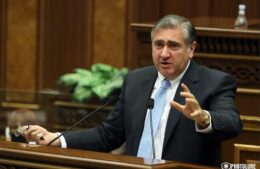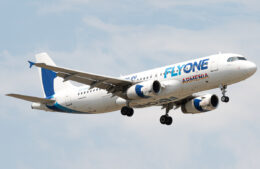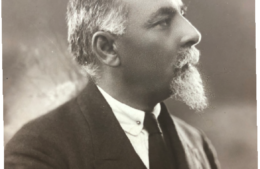THE RECENT SHIPPING OF RUSSIAN WEAPONS IN BAKU OR ONCE AGAIN ABOUT THE BALANCE OF POWER BETWEEN THE PARTIES IN THE NAGORNO-KARABAKH CONFLICT
- (0)
– By David Petrosyan
The recent arms shipping from Russia to Azerbaijan of nearly $1 billion
have been controversial in the Armenian press, among experts and in the
political field.
Recall that, according to the list of publications the supply includes
offensive weapons such as 94 T-90S tanks, 100 armored infantry fighting
vehicles BMP-3, 18 self-propelled artillery units “MSTA-C”, 18 multiple
launch rocket systems ‘Smerch’, 18 self-propelled artillery “Vienna”,
six units of heavy flamethrower system TOS – 1A “Sunshine”, a variety
of machines for maintenance, spare parts, etc.
The delivery is conducted by the Russian Federation due to agreements
signed in 2010 – 2011 by President D. Medvedev and Defense Minister
Anatoly Serdyukov. The latter, as it is known, was a defendant in a
number of corruption scandals.
In those years, Russia also supplied Azerbaijan with two divisions of
anti-missile systems S-300PMU-2, air defense missile systems such as
“Tor-2ME” 60 transport helicopters Mi-17 and 24 attack helicopters
Mi-35M for a total of $3,000,000,000.
Also recall that Azerbaijan has purchased large quantities of arms from
Israel, Ukraine and Belarus in recent years.
Some experts and politicians in Armenia believe that the above-mentioned
arms shippings contribute to an imbalance in armaments between Armenia
and Nagorno-Karabakh on one hand, and Azerbaijan on the other, in
favor of the latter.
According to this point of view, these circumstances will ensure that
Azerbaijan starts fighting in the Nagorno-Karabakh conflict zone and
in the border area with Armenia and will achieve military victory,
though the following circumstances are not taken into account:
– Russia continues to supply Armenia, as a member of the CSTO
military equipment on its domestic prices that are cheaper than those
to Azerbaijan. Moscow is also supplying arms to Armenia in the
framework of bilateral military-technical cooperation, which is often
not included in the relevant UN registers.
– Russia’s 102nd base is on the territory of Armenia, which
constrains a possible military intervention by Turkey in case of an
escalation of a conflict in Nagorno-Karabakh and the outbreak of
hostilities on the Armenian-Azerbaijani border. This makes it possible
for Armenia to concentrate its main power and resources in the
easterly direction, which means against Azerbaijan. At the same time
Azerbaijan cannot concentrate all its power and resources only against
Armenia and Nagorno-Karabakh, as it has threats from other directions,
including from Iran.
– The military balance also includes the well-equipped defense in
military engineering in the Nagorno-Karabakh conflict zone and on the
Armenian-Azerbaijani border.
– The heavy weapons supplied to Armenia can be upgraded and are
being upgraded. No attention is paid to the fact that for example,
the same tank T-90, in fact, is the modernized version of the T-72B,
which is used by the Armenian army and the Defense Army of Nagorno –
Karabakh Republic.
– By supplying arms to Baku and Yerevan, Moscow, in its regional
military-technical policy, adheres to the course to maintain a balance
between all three parties in the Nagorno-Karabakh conflict. This
balance is increasingly taking an asymmetric format. A partly similar
military-technical policy was conducted by the U.S for many years in
relation to Israel, Egypt, Turkey and Greece.
However, the recent deliveries of Russian weapons, as usual, have been
used by various interest groups in both Armenia and Azerbaijan,
including at the highest level, to promote their interests.
In particular:
– Pro-Western Armenian pressure groups have used the fact of
Russian arms supplies to Baku to provoke anti-Russian sentiment,
– This fact was used by President Ilham Aliyev to organize another
round of anti-Armenian hysteria in Baku on the eve of the presidential
elections to be held this fall. Several statements were made by
President Ilham Aliyev after the military parade on June 26 in Baku.
In particular, the Armenian residents learned from these statements
that the army of Azerbaijan is 10 times the Armenian army by its
military power. In addition, according to Aliyev, the Armenians of
Armenia and Nagorno-Karabakh are living on historical Azerbaijani
lands.
In general, the people of the region and the entire world are used to
such rhetoric.
The experts understand that the Azerbaijani army does not have any
advantages over the armed forces of Armenia, especially for the
implementation of the blitzkrieg plans (lightning war), which are
incorporated in the military doctrine of Azerbaijan.
However, the international organizations, especially the OSCE, should
pay attention to the fact that Azerbaijan:
– Violates quotas for heavy and offensive weapons set by the
Treaty on Conventional Armed Forces in Europe.
– Refuses to comply with the terms of the “Agreement to
consolidate the cease-fire” (sometimes referred to as an agreement on
the settlement of incidents) in the Nagorno-Karabakh conflict, which
entered into force on 6 February 1995. Recall that de-jure it was a
unique kind of agreement on the Nagorno-Karabakh conflict, which was
concluded under the auspices of the OSCE, and then it was properly
registered in the organization.
However, as we see it, the international organizations do not tend to
pay attention yet to the failure of Baku to comply with the two
aforementioned documents. There is also the failure of the Foreign
Ministry of Armenia in this, which does not remind its partners in the
OSCE about the need to monitor the implementation of existing
agreements and contracts.



















